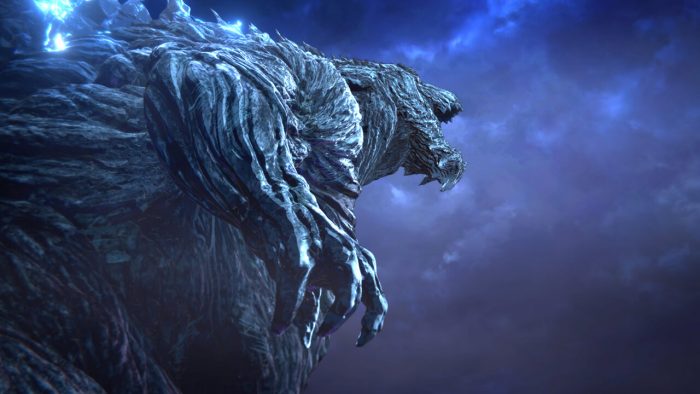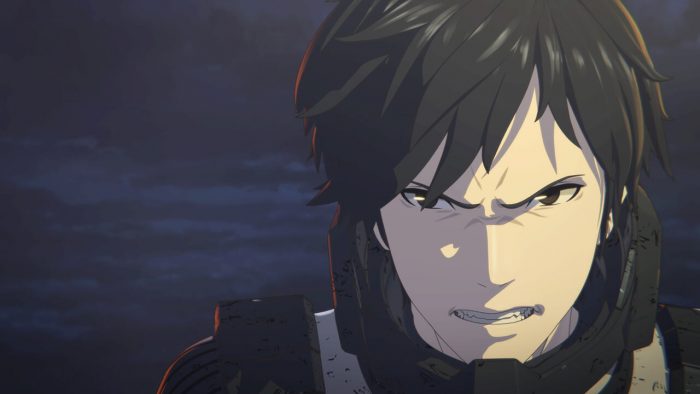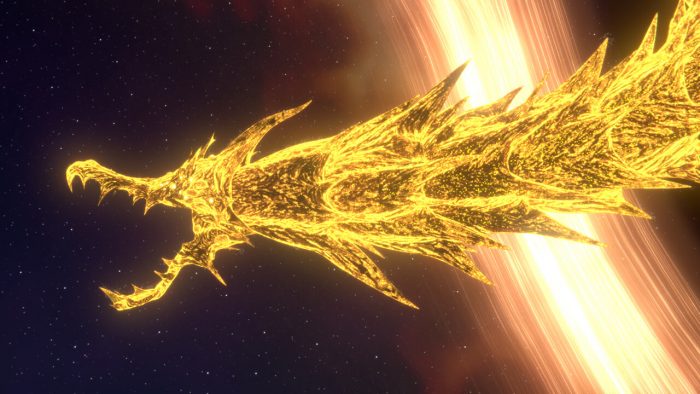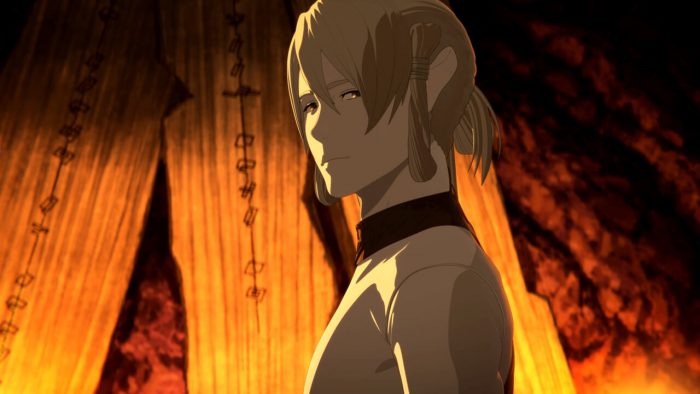'Godzilla: The Planet Eater' Review: King Ghidorah Helps End Netflix's Anime Godzilla Trilogy In A Grand Fashion
Netflix's anime Godzilla trilogy has suffered in some ways from the staggered method of its release. The installments have been spaced out about six months apart from each other so that the movies could enjoy a theatrical run in Japan before their worldwide Netflix release. In retrospect, this is a series that might benefit more from a binge-watch.
The concluding film, Godzilla: The Planet Eater, vindicates the trilogy in a way that manages to stay true to it while also being true to the franchise and what fans have come to expect when they sit down for a Godzilla movie. If the name Ghidorah isn't on your radar, it should be. He's Godzilla's arch-nemesis, the fearsome three-headed dragon who will be making his live-action Hollywood debut next year in Godzilla: King of the Monsters. In The Planet Eater, Ghidorah makes his first appearance in animated form, where he and the cult of death surrounding him prove themselves to be the trilogy's secret weapon: capable of plumbing great thematic depths through kaiju action and character intrigue.
On Godzilla's 64th birthday, November 3, 2018, The Planet Eater will make its world premiere as the closing film of the Tokyo International Film Festival. The film screened for the press this week in advance of its festival premiere and we've got an early review of it for you right here.
Godzilla: The Planet Eater is the eventful third act of a story that initially struggled under the weight of franchise expectations. To their detriment, perhaps, the first two films in Netflix's anime trilogy — Godzilla: Planet of the Monsters and Godzilla: City on the Edge of Battle — continued the recent franchise trend of withholding sight of the title monster. Instead, the focus shifted squarely to human and humanoid characters, most prominently a young upstart named Haruo with a grudge against Godzilla.
Like Shin Godzilla, the last live-action Japanese Godzilla movie, this approach could be alternatively "fascinating and frustrating," depending on what you look for in a giant monster movie. Since Gareth Edwards' 2014 Godzilla reboot, we've entered an era where both stateside and Japanese filmmakers seem to be striving to return Godzilla to his roots as a walking disaster: not a natural disaster, but a manmade calamity like the atomic bomb or a nuclear meltdown.

Re-infusing the King of Monsters with some gravitas — trading mushroom cloud imagery for the obscurity of his silly suitmation adventures — is an admirable aim. However, over sixty-plus years, the series has expanded beyond scenes of citywide destruction to incorporate kaiju-on-kaiju battles. Some might say those have become an indispensable component of the Godzilla franchise. A little less Haruo, a little less Aaron Taylor-Johnson, and a little more Mothra or Rodan sometimes goes a long way.
At times, both Planet of the Monsters and City on the Edge of Battle seemed more indebted to Planet of the Apes than their own franchise. In Planet of the Monsters, time dilation caused Haruo and the residents of his spaceship to arrive back on earth thousands of years in the future, after the planet had been overrun by monsters (in this case, rock pterodactyls and Godzilla instead of apes). City on the Edge of Battle introduced the telepathic, underground-dwelling Houtua tribe — distant descendants of Earth's human population, who seemed to also descend, cinematically, from the mutants in Beneath the Planet of the Apes.
Godzilla: The Planet Eater picks up where we left off at the end of City on the Edge of Battle. Mechagodzilla City has been destroyed and Haruo's childhood friend, Yuko, has been rendered comatose, her body overtaken by self-sustaining "nanometal." Above Earth, the Bilusaludo aliens are calling for Haruo's head, arguing that he betrayed the three races of the United Earth by refusing to fuse with the nanometal and become part of Mechagodzilla City. As it turns out, their crazed colonel, Galu-Ga (who perished at the end of the last movie), isn't the only alien in this series who thinks everyone should sacrifice their lives in order to facilitate a monstrous anti-Godzilla of sorts.
Haruo is still front and center in The Planet Eater. To prevent discord, however, he feigns going AWOL, putting himself into hiding. Among the survivors, the balance of power shifts away from him toward the rise of a religious faction, led by the Exif alien, Metphies.
There's some intrigue at first because it's not entirely clear what Metphies' motivations are. Appearances can be deceiving, but in Planet of the Monsters, the platinum-haired, curvy-eared Exif appeared almost angelic, like the Elves in The Lord of the Rings. Metphies himself seemed to help Haruo, getting him released from the spaceship brig before speechifying at the end about how "fleeting lives destined to die forget their humbleness and sing praises of their glory," thereby provoking "the wrath of the divine, the inevitable incarnation of destruction."

There's more ornate language like that in The Planet Eater, as it gradually becomes clear that Metphies' words and scenes of Exif-led praying in the previous movies were laying the seeds for a full-on alien death cult to emerge in this film. There are some wacky scenes and wacky lines of dialogue in The Planet Eater, but it's my kind of crazy. If you weren't fully on board with Netflix's anime Godzilla trilogy before this, you might be by the time the death cult starts to bid "come hither" to the "Golden Demise."
That's Ghidorah, of course. He's also referred to as the "Winged Demise," but we never really see his wings. Here he's portrayed as a golden energy snake: a long-necked, hydra-like, extradimensional entity who is summoned to Earth through a wormhole and three swirling rifts in the clouds (one for each head).
The movie does build Ghidorah up so that the first utterance of his "golden name," which is worthy of chants, bears enormous weight. He's the King of the Void. All life is an offering to him, and in his unholy presence, human beings are mere soup for the gods. If he doesn't dismember them, they might just remove parts of their own body out of pure fanaticism.
Initially, Godzilla stands dormant in The Planet Eater, and it looks as though the King of Monsters will be sidelined yet again in his own movie. In City on the Edge of Battle, Godzilla only showed up in the third act, and even then, he only logged a grand total of five and a half minutes screen time (as this video attests).
In The Planet Eater, it feels like the monster action comes sooner. On this future earth, there are no cities left for the monsters to raze, but they can still bear down on spaceship windows with terrifying largeness. When Godzilla awakens and faces off with Ghidorah in an open fighting expanse, it feels (for the first time in this series?) like we are really and truly in the middle of a legit Toho Godzilla film.

In the movie, cult members offer B-movie prayers like, "Mighty egg, save him from this loathsome dream." They might just as well have been praying on behalf of viewers who felt impatient with the previous lack of kaiju in this series. When the cultists beseech Ghidorah, "Bring us a glorious finish," it seems those prayers have been answered for the trilogy itself.
Not everything is perfect in The Planet Eater. There's a montage with questionable CG effects, and at one point, the big Godzilla vs. Ghidorah battle is undermined by peaceful music. The framing of their confrontation is also more impressive than the actual battle. Take that for what you will.
The big-screen presentation here may have helped the movie's cause. Who knows, The Planet Eater might not register with people or leave as much of an impression if they're viewing it on the small screen and treating it as a time-waster, just another title bubbling up through forgettable foam in the sea of Netflix content.
Having said that, there are other aspects to this film that render it in a better light than its two anime predecessors and indeed, retroactively make those movies seem better, as well. In terms of memorable movie moments, The Planet Eater is, like its opening image, a kaleidoscope of gold.
Rather than revert to a big dumb monster movie, The Planet Eater is able to balance its kaiju action with life-and-death concerns while wrapping up threads of character drama woven through the trilogy as a whole. Even Haruo's name, which comes from the Japanese seasonal word, haru, meaning, "spring," takes on a higher meaning. The movie plays with rich themes that might leave you thinking (or scratching your head) as you wait for the post-credits scene.
There is one of those, so stick around, especially if you're baffled by the movie's ending and are looking for further explanation. That's a distinct possibility for some people. It's how I felt at first, but the more I thought about the movie, the more I felt I understood the spirit of it and what it was trying to say about human nature through the lens of Japanese filmmaking.
"What is 'Godzilla'?" the movie's website asks. "What should people 'do'?" The Planet Eater raises interesting questions and the answers to those questions might be challenging for some viewers.
While in hiding, pretending to be AWOL, Haruo reflects on his failure in the last film. One of the twin Houtua girls he's buddied up with tells him that he didn't actually lose because in the face of an unbeatable force like Godzilla, living, surviving, is winning.
Haruo can accept that and try to carve out his own slice of happiness somewhere, or, in the face of humanity's own insatiability — its endless cycle of foolhardiness — he can "choose to lose." Either way, there's always going to be a three-headed monster out there, gazing at him and us from beyond the void. As the movie puts it: "As long you have life, Ghidorah will be watching."
***
Godzilla: The Planet Eater hits theaters in Japan on November 9, 2018. If it follows the release model of the two previous trilogy installments, then it should be available globally on Netflix two months later, on January 9, 2019.
